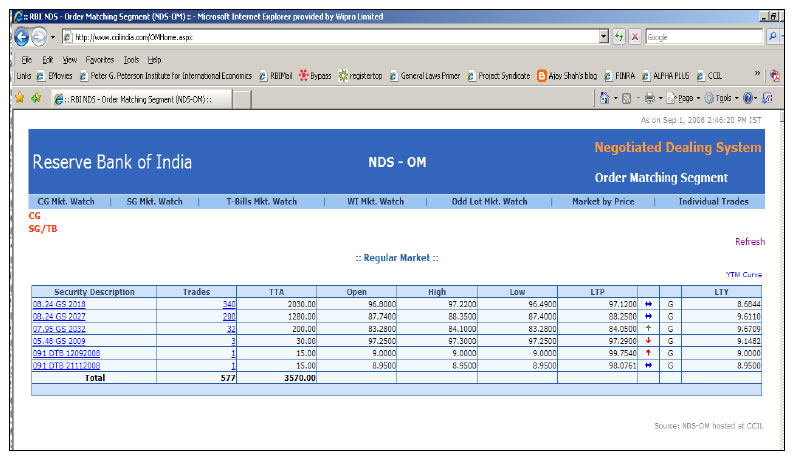FAQ Page 1 - ஆர்பிஐ - Reserve Bank of India
Government Securities Market in India – A Primer
14.1 The return on a security is a combination of two elements (i) coupon income – that is, interest earned on the security and (ii) the gain / loss on the security due to price changes and reinvestment gains or losses.
14.2 Price information is vital to any investor intending to either buy or sell G-Secs. Information on traded prices of securities is available on the RBI website http://www.rbi.org.in under the path Home → Financial Markets → Financial Markets Watch → Order Matching Segment of Negotiated Dealing System. This will show a screen containing the details of the latest trades undertaken in the market along with the prices. Additionally, trade information can also be seen on CCIL website http://www.ccilindia.com/OMHome.aspx. On this page, the list of securities and the summary of trades is displayed. The total traded amount (TTA) on that day is shown against each security. Typically, liquid securities are those with the largest amount of TTA. Pricing in these securities is efficient and hence UCBs can choose these securities for their transactions. Since the prices are available on the screen they can invest in these securities at the current prices through their custodians. Participants can thus get near real-time information on traded prices and take informed decisions while buying / selling G-Secs. The screenshots of the above webpage are given below:
NDS-OM Market

The website of the Financial Benchmarks India Private Limited (FBIL), (www.fbil.org.in) is also a right source of price information, especially on securities that are not traded frequently.
External Commercial Borrowings (ECB) and Trade Credits
E. AVERAGE MATURITY PERIOD
All you wanted to know about NBFCs
B. Entities Regulated by RBI and applicable regulations
The list of registered NBFCs is available on the web site of Reserve Bank (www.rbi.org.in) under ‘Regulation → Non-Banking’. Further, the instructions issued to NBFCs from time to time through circulars and/ or master directions are hosted on the Reserve Bank’s website under ‘Notifications’, and some instructions are issued through Official Gazette notifications and press releases as well.
Foreign Investment in India
Indian Currency
B) Banknotes
Fifteen languages are appearing in the language panel of banknotes in addition to Hindi prominently displayed in the centre of the note and English on the reverse of the banknote.
Core Investment Companies
B. Registration and related matters:
Ans: CICs need not meet the principal business criteria for NBFCs.
Biennial survey on Foreign Collaboration in Indian Industry (FCS)
Some important definitions and concepts
Ans.: An Indian company is called as Foreign Associate if non-resident investor owns at least 10% and no more than 50% of the voting power/equity capital or where non-resident investor and its subsidiary(s) combined own at least 10% but no more than 50% of the voting power/equity capital of an Indian enterprise.
Coordinated Portfolio Investment Survey – India
What to report under CPIS?
Ans.: If the responding entity does not have any portfolio investment asset during the reference period, then that entity is required to submit NIL survey schedule to the generic email ID of the Reserve Bank as per the instruction in the survey schedule.
Targeted Long Term Repo Operations (TLTROs)
FAQs pertaining to On Tap TLTRO/ reversal of TLTRO/ TLTRO 2.0 transactions
Ans: Banks can submit their request for exercising the repayment option till October 28, 2020. On repayment of funds availed under TLTRO/ TLTRO 2.0, the associated securities shall be shifted out of the HTM category. The shifting of the TLTRO/ TLTRO 2.0 investments out of HTM shall be in addition to the shifting of investments permitted at the beginning of the accounting year and subject to adherence to the guidelines contained in the Master Circular – Prudential Norms for Classification, Valuation and Operation of Investment Portfolio by Banks dated July 1, 2015. These investments under TLTRO/ TLTRO 2.0 against which funds are being repaid will not be exempted from reckoning under the large exposure framework (LEF) and computation of adjusted non-food bank credit (ANBC) for the purpose of determining priority sector targets/sub-targets.















